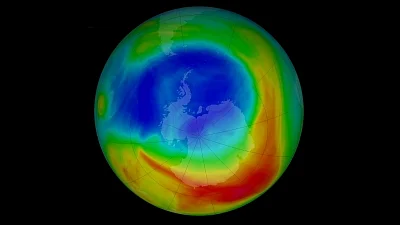The ozone layer is steadily healing courtesy of decades of effort to reduce ozone damaging chemicals, according to a new UN report.
The rate of recovery indicates that the hole in the ozone layer over Antarctica could fully mend over the next 43 years.
What does this mean for humans? How did we reach this goal? Keep reading.
Ozone Layer Hole Over Antarctica Healing, Finds UN Report - What Does This Mean?
1. Why Does This Matter?
A hole was discovered in the ozone layer over Antarctica in May 1985, by the British Antarctic survey. Not long after, scientists had discovered that chemicals like chlorofluorocarbons, used as solvents in refrigerators, were harmful to the ozone layer.
The ozone layer is a part of the Earth's stratosphere that absorbs up to 97-99 percent of the sun's ultraviolet radiation, which could otherwise be harmful towards life on Earth.
Increased exposure to ultraviolet rays would also detrimentally affect ecosystems and damage crops and plants. It's also a major factor in skin cancer.
What's Happening Now?
The overall phase down of chemicals has led to notable recovery of the ozone layer in the upper stratosphere and decreased human exposure to ultraviolet rays, the report said.
The Arctic ozone hole has been steadily recovering since 2000. The hole in the ozone layer above Antarctica is expected to recover by 2066 and by 2045 over the Arctic, the report adds.
Expand2. How Did We Do This?
Upon the alarming discovery of the depleting ozone layer, the Montreal Protocol was adopted in September 1987 by 197 countries. It is one of the first Unites Nations treaties to have received universal ratification and is considered the most successful global environmental action.
The Montreal Protocol on Substances that Deplete the Ozone Layer endeavored to regulate or phase out approximately 100 synthetic chemicals that were harmful to the ozone layer. This was phased down on different timelines by both developed and developing countries.
The latest progress report for the Protocol has revealed that nearly 99 percent of banned ozone depleting chemicals have been successfully phased out.
“Over the last 35 years, the Protocol has become a true champion for the environment. The assessments and reviews undertaken by the Scientific Assessment Panel remain a vital component of the work of the Protocol that helps inform policy and decision-makers, ”said Meg Seki, Executive Secretary of the UN Environment Programme’s Ozone Secretariat to UN News.
Expand3. What Now?
The report emphasised on the positive impact of the Montreal Protocol in climate change mitigation.
Efforts of the Protocol have invariably helped avoid global warming by an estimated 0.5°C, the report said.
In 2016, an amendment to the protocol included the Kigali Amendment that required the phase-down of hydrofluorocarbons (HFCs) which, while not directly harmful to the ozone layer, contribute to accelerating climate change.
The report estimates that the amendment will aid in avoiding another 0.3–0.5°C of global warming by the year 2100.
(Our on-ground climate journalism needs your insights, ideas, and financial support - as we cover the biggest crisis of our times. Become a Q-Insider so we can bring more such stories to light.)
Expand
Why Does This Matter?
A hole was discovered in the ozone layer over Antarctica in May 1985, by the British Antarctic survey. Not long after, scientists had discovered that chemicals like chlorofluorocarbons, used as solvents in refrigerators, were harmful to the ozone layer.
The ozone layer is a part of the Earth's stratosphere that absorbs up to 97-99 percent of the sun's ultraviolet radiation, which could otherwise be harmful towards life on Earth.
Increased exposure to ultraviolet rays would also detrimentally affect ecosystems and damage crops and plants. It's also a major factor in skin cancer.
What's Happening Now?
The overall phase down of chemicals has led to notable recovery of the ozone layer in the upper stratosphere and decreased human exposure to ultraviolet rays, the report said.
The Arctic ozone hole has been steadily recovering since 2000. The hole in the ozone layer above Antarctica is expected to recover by 2066 and by 2045 over the Arctic, the report adds.
How Did We Do This?
Upon the alarming discovery of the depleting ozone layer, the Montreal Protocol was adopted in September 1987 by 197 countries. It is one of the first Unites Nations treaties to have received universal ratification and is considered the most successful global environmental action.
The Montreal Protocol on Substances that Deplete the Ozone Layer endeavored to regulate or phase out approximately 100 synthetic chemicals that were harmful to the ozone layer. This was phased down on different timelines by both developed and developing countries.
The latest progress report for the Protocol has revealed that nearly 99 percent of banned ozone depleting chemicals have been successfully phased out.
“Over the last 35 years, the Protocol has become a true champion for the environment. The assessments and reviews undertaken by the Scientific Assessment Panel remain a vital component of the work of the Protocol that helps inform policy and decision-makers, ”said Meg Seki, Executive Secretary of the UN Environment Programme’s Ozone Secretariat to UN News.
What Now?
The report emphasised on the positive impact of the Montreal Protocol in climate change mitigation.
Efforts of the Protocol have invariably helped avoid global warming by an estimated 0.5°C, the report said.
In 2016, an amendment to the protocol included the Kigali Amendment that required the phase-down of hydrofluorocarbons (HFCs) which, while not directly harmful to the ozone layer, contribute to accelerating climate change.
The report estimates that the amendment will aid in avoiding another 0.3–0.5°C of global warming by the year 2100.
(Our on-ground climate journalism needs your insights, ideas, and financial support - as we cover the biggest crisis of our times. Become a Q-Insider so we can bring more such stories to light.)
